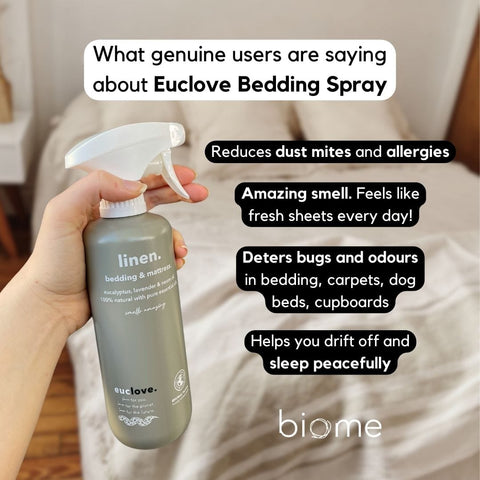
It seems to be the sneezy season of dust mites all year round in Australia! If you're like me, someone in your household is constantly sniffling, sneezing, or suffering from eczema or asthma. Dust mites are likely to be part of the reason. Even if you are not overtly suffering, you're no doubt keen to maintain a clean living environment and reduce these tiny pests as much as possible.
Dust mites are common cause of allergy and asthma symptoms in around one third of people. These allergen mites thrive in warm, humid conditions, feasting on dead skin cells and nesting in your bedding, carpets, and upholstery. The health implications can be significant, ranging from mild allergic reactions to severe asthma attacks.
Given the frustrating health impacts, many of us seek effective solutions to get rid of house dust mites. While some commercial chemical sprays are available, I prefer natural alternatives that use essential oils in the ingredients. For this, there are two options of sprays for your sheets, mattress, pillows, quilts, and all forms of bedding:
1. Make a home made spray that kills dust mites with essential oils and vinegar ; or
2. Use a ready to go spray, such as Euclove Linen Spray
Here we cover how to make your own to use at home and take with you when you travel:
How to make dust mite spray with essential oils
Will vinegar and water kill dust mites?
With high enough concentration, vinegar by itself may work. But, it is important to know that white vinegar purchased at the supermarket is only about 3% to 5% concentration (it is mostly diluted with water to begin with). In this recipe, the vinegar is mostly used to help disperse the essential oils.
Here's our simple recipe for how to make dust mite spray for your mattress, couch, sofas, curtains, bedding, and other dust mite hangouts (always patch test first of course):
Ingredients:
- Water: 1 cup cooled boiled water (removes chlorine and other contaminants)
- White vinegar: 1 cup (helps to dissolve essential oils and has natural disinfectant properties - see alternatives to vinegar below
- Eucalyptus oil: 15 drops (as a potent dust mite killer)
- Clove oil: 10 drops (for its acaricidal properties)
- Lavender oil: 10 drops (adds a pleasant scent and helps repel mites)
Equipment:
- Glass spray bottle: we choose a glass spray bottle as glass is resistant to essential oils. Essentials oils like eucalyptus can dissolve plastic over time.
Instructions:
- Add the oils: Add into the spray bottle the eucalyptus, clove, and lavender oils. This mixture harnesses the acaricidal properties of each oil (acaricidal means a pesticide that kills mites and ticks).
- Add the vinegar & water: add the white vinegar and then the water into the bottle. The vinegar helps to emulsify the oils in the water, allowing for a more consistent mixture.
- Shake: Close the bottle and shake well to ensure everything is thoroughly mixed. Also shake well before every use.
- Usage: Spray the mixture lightly on bedding, curtains, and other areas where dust mites are likely to live. Do not saturate the fabrics; a light mist is sufficient.
- Repeat: For best results, use the spray regularly, such as weekly, to help keep dust mite populations under control.
Alternatives to vinegar for a dust mite spray
If you prefer not to use white vinegar in your dust mite spray, there are several alternatives that can help dissolve essential oils and offer additional benefits:
-
Rubbing alcohol or witch hazel: Both of these can serve as effective alternatives to vinegar. They help in dispersing the essential oils evenly and also have disinfectant properties. Rubbing alcohol evaporates quickly, reducing the wetness left on fabrics. If using these, you do not need to use as much because they are concentrated and not already diluted like white vinegar - just use two tablespoons per cup of water.
-
Vodka: A clear, odourless vodka can be used as a base for the essential oils. It has similar dispersing and quick-drying properties as rubbing alcohol, and it won't leave a residue or smell once it evaporates.
-
Hydrosols: These are floral waters that are byproducts of the distillation process of essential oils. Hydrosols like rose water or lavender water can add extra anti-mite properties and a pleasant fragrance to your spray.
-
Distilled water: If you're only looking for a diluting agent without additional properties, distilled water alone can be used. It lacks the dispersing properties of alcohol or vinegar, so you’ll need to shake the mixture well before each use.
For your home made dust mite spray, choose the alternative that best suits your needs based on the properties you want to add to your dust mite spray. Each alternative provides a slightly different benefit and can be tailored to your preferences or what you have on hand.
What can I spray my mattress with to kill dust mites?
Always test the spray on a small, inconspicuous area of the fabric to ensure it does not cause discoloration or damage. This DIY mattress spray not only helps in reducing dust mites but also leaves a fresh scent in your home.
Essential oils contain compounds that repel or kill insects, including dust mites. The best essential oils for getting rid of dust mites in your mattress are clove, rosemary, eucalyptus oil, and tea tree oil.
Tea tree oil is particularly effective for an antibacterial mattress spray.
How to make dust mite spray for dog beds?
Making a dust mite spray for dog beds is a great way to ensure your furry friend's sleeping area is clean and free from allergens.
Adapt the recipe above, but exclude clove oil, which can affect dogs and cats. Clove oil and Tea tree oil should never be applied in an undiluted form on cats and dogs, or ingested by them. Thus it is best not sprayed on their bedding, which they may lick.
- Ensure your dog does not have allergies to any of the oils used. While eucalyptus and lavender are generally safe for dogs, each pet is different, and it's good to confirm before regular use.
- Always spot test the spray on a small, inconspicuous area of the bed to ensure it does not cause any discolouration or adverse reactions.
Should I use Neem Oil in a dust mite spray?
Neem oil can be a good choice for a natural dust mite spray due to its insecticidal properties. It's effective against a variety of pests and is commonly used in organic farming and gardening. Here are some reasons why Neem oil might be suitable for combating dust mites:
-
Insecticidal properties: Neem oil contains compounds that are toxic to many pests, including dust mites. It disrupts the life cycle of mites, preventing their reproduction and growth.
-
Safety: Compared to synthetic pesticides, Neem oil is generally safer for use around the home. It's non-toxic to humans and pets when used properly, though it should still be used in a diluted form to avoid potential irritation.
-
Preventive and curative: Neem oil can help prevent dust mite infestations and can also treat existing populations.
While Neem oil is effective and safer than many chemical alternatives, it's important to use it cautiously, especially around pets and children. Always ensure proper ventilation when applying it indoors, and consider consulting with a professional if you have severe allergies or asthma.
How to use neem oil for dust mites
-
Dilute the neem oil: Mix a few drops of Neem oil with water and a mild soap or detergent, which acts as an emulsifier to mix the oil and water. Use about one teaspoon of neem oil per litre of water.
-
Add essential oils: For added effectiveness and a pleasant scent, you can combine Neem oil with essential oils known to repel mites, such as eucalyptus or lavender oil, as shown in our recipe above.
-
Spray the affected areas: Use a spray bottle to apply the mixture to areas where dust mites are likely to be found, such as bedding, furniture, and curtains. Make sure to test the spray on a small area first to ensure it doesn’t stain or damage the fabric.
-
Regular application: For best results, apply the spray regularly, about once a week, to keep dust mites at bay.
Any other natural solutions for killing dust mites?
Diatomaceous earth can be effective in killing dust mites. Diatomaceous earth is a fine powder made from the fossilised remains of tiny aquatic organisms called diatoms. The microscopic sharp edges of the diatoms can cut through the exoskeletons of dust mites and other small pests, causing them to dehydrate and die.
When using diatomaceous earth to combat dust mites, it's important to use the food-grade version to ensure safety, especially around pets and children. Here are a few tips on how to use diatomaceous earth to get rid of dust mites:
-
Apply lightly: Sprinkle a thin layer of diatomaceous earth on areas where dust mites are likely to be found, such as mattresses, pet beds, carpets, and upholstered furniture.
-
Leave it: Allow the diatomaceous earth to sit for several hours or even a few days to maximize its effectiveness. The longer it remains in place, the more dust mites it can dehydrate.
-
Clean up: Vacuum up the diatomaceous earth thoroughly after the treatment. Use a vacuum with a HEPA filter to avoid dispersing fine particles back into the air.
-
Repeat if necessary: Depending on the severity of the dust mite problem, you might need to repeat the application periodically.
Remember to wear a mask when applying diatomaceous earth to avoid inhaling the fine dust, and keep the area ventilated.
MORE READING
Everything You've Been Afraid to Ask About the Bugs That Share Your Bed
How to Prevent Scabies at Home









































